The Uncanny Language of Medical Instagram
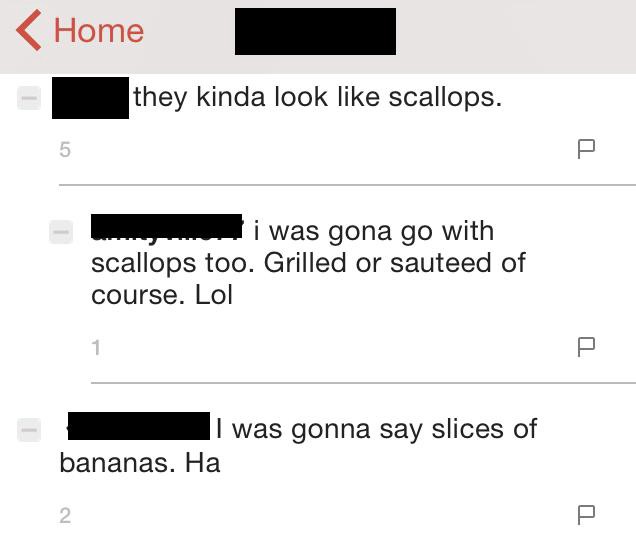
A few months ago a friend showed me a story about an app called Figure 1. It was billed as “Medicine’s Answer to Instagram,” and had apparently just raised a couple million dollars. I downloaded it. I am not a doctor, nor did I claim to be one when I signed up. I checked “Journalist” from the “Non-Healthcare Professional” menu. This got me in on a sort of limited basis (selecting “Other” would have worked too). I couldn’t post — that’s for pros — but I could see everything.
To a “Non-Healthcare Professional” the main Figure 1 feed is shocking. It’s an infinite scroll of graphic medical photos — growths, infections, fractures, rashes, traumatic injuries, birth defects. I’ve had the app for a few months but I can rarely bring myself to open it. This is stuff that doctors either want to show their colleagues or need help with, so it’s full of superlatives and oddities. Anyone know what this is? Seen this before? Got a diagnosis? Nope! Sure don’t. But I’m here, somehow, in the room with you.
The question of consent is immediate. Nothing, affliction-wise, is off limits — it’s all there, and the question of how it got there is unavoidable. (The app hosts over a million new pictures a day.) The matter of consent is deeply designed into the app and its terms of service. The company’s recommendations are clear. “Before sharing online,” the company says, “protect your patients’ privacy by removing their identifying information. On Figure 1, we ask you to remove 18 identifiers (which have been drawn from HIPAA) and provide you with the tools to do so. Use these tools to keep your patients’ identities safe.” There are paid moderators who monitor these things.
The company is also clear about what the app is for — education, sharing with other doctors — and matters of consent:
Above all else, you should always apply the same ethical principles you use in your practice to what you post online. Avoid saying anything about a patient online that you would not say in front of them.
If you are posting an image to Figure 1, you may need written consent from the patient (depending on your jurisdiction and workplace). Figure 1 provides a country-specific consent form right in the app. Alternately, there are written consent forms available at most institutions. Know the consent rules that apply to you and follow them with respect toward your patients.
The app itself presents doctors with a default touchscreen consent form, which they in turn present to their patients. It looks something like this:
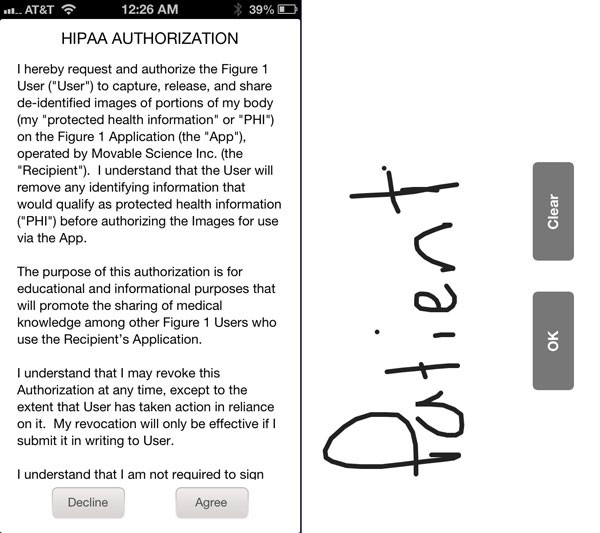
Screenshot from iMedicalApps.
The language here is exact. It’s short enough for a patient to read and can be represented fairly in a short bedside conversation that might go something like this: “Would it be OK with you if I shared photos of your condition with my colleagues? We use an app — it’s like Instagram for doctors — where we share interesting information and ask for additional opinions.” I could imagine saying yes to that, as, say, my index finger dangled from my hand by a thin strip of skin. I would also understand, intuitively, that having a sorted, up-to-date feed of recent field-specific photos, with conversations and context attached, could be useful to my doctor and others. Or to students.

The question of whether or not doctors are consistently asking for consent is important but hard to pin down — there are photos with descriptions (“from a few months ago,” etc.) that make explicit consent seem doubtful, but they, like most of the others, are anonymous.
But patient consent is a lot more interesting from another, more personal vantage. That is: Do patients really know what they’re consenting to? For that matter, do doctors know exactly what they’re asking, from any perspective but their own?
What Figure 1 does is take conversations that doctors or students might have had in private — over email, over coffee, at the golf course, after class — and puts them in a semi-public place. They are therefore conducted with professional familiarity verging on casualness. They read like I imagine actual doctors talk, when they’re looking at something weird or novel or horrible or confounding or even funny:
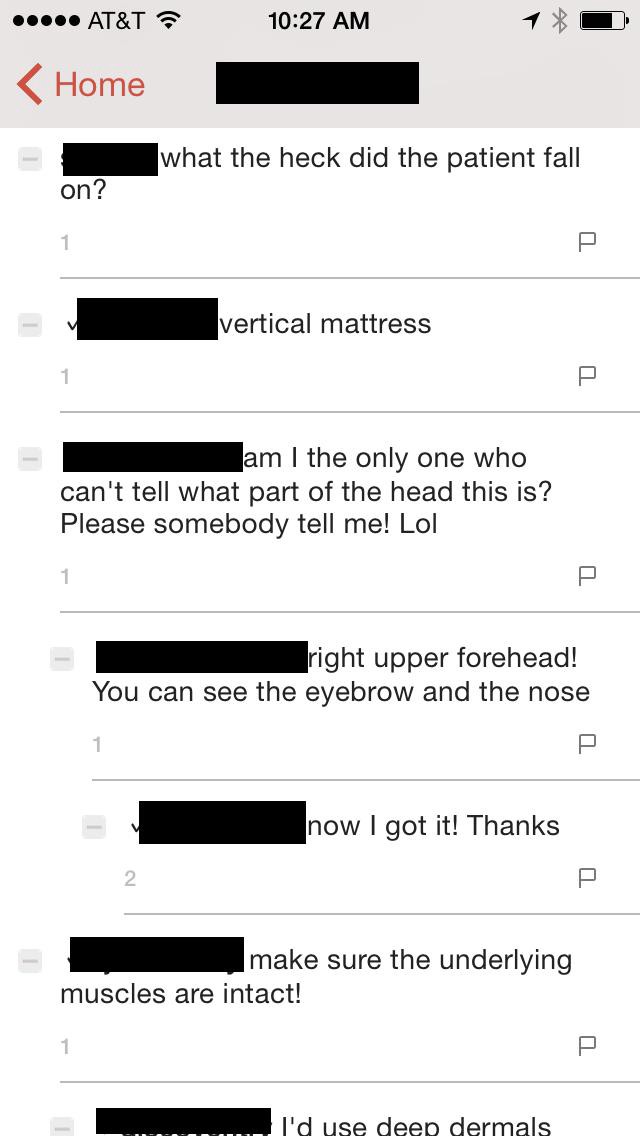
The discussions are inflected with internet-speak — LOLs and ROFLs under funny-looking kidney stones — and the doctors make jokes. This is a genuinely new thing, this weird doctor social network, so the emergence of new styles and tropes is inevitable. An especially popular post type is “guess the diagnosis”:
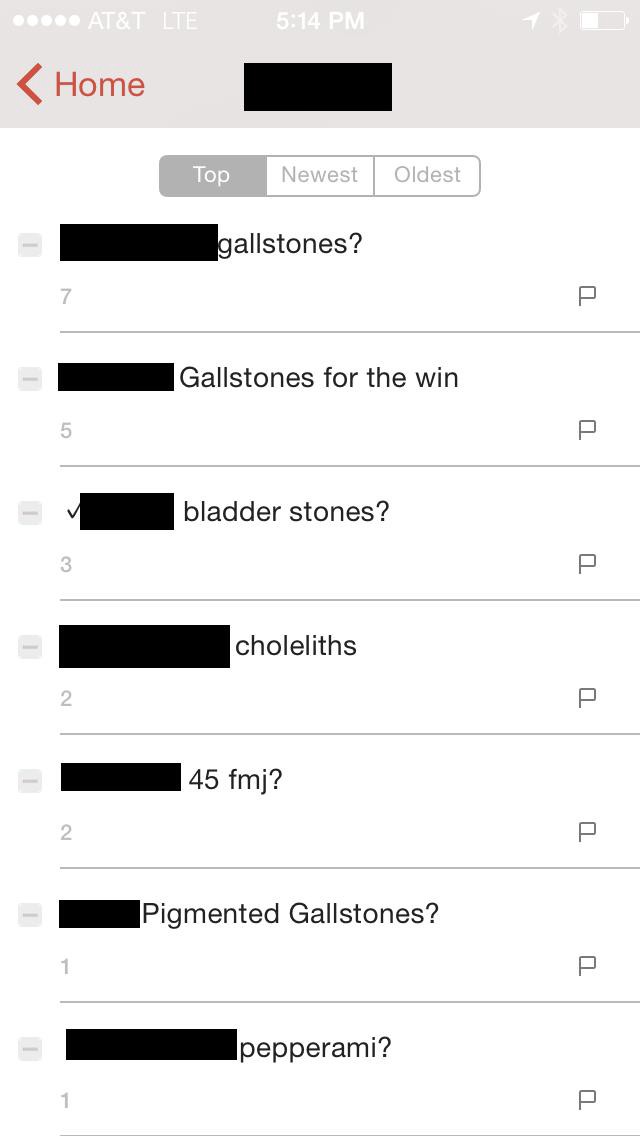
Gallstones for the win.
I’ve redacted all the usernames (and they are usernames, not actual names) out of politeness. I’m also not including any medical imagery because whether or not these patients consented to their photos being posted on Figure 1 I doubt any of them added “and put it on some blog, too” after signing. (It’s also against the Figure 1 terms of service, but whatever.)
But I also wouldn’t take it for granted that patients understand exactly what getting posted on Figure 1 looks like in practice. The tone is jarring. Not cruel, exactly, just sort of unfeeling. Certainly not patient-facing.
It’s how you must have to talk if you’re a professional death-delayer, except with some extra social media flourishes and the visual trappings of an photo of a fancy meal or a sunset. Not only does it confirm what most patients probably would have guessed — that doctors have their own style of shop talk — it makes casual medical speech less ephemeral, and pushes it at least part of the way out into the open. Reading comments in this app is like eavesdropping on a table of doctors in a hospital cafeteria, infinitely. Figure 1’s request that users “avoid saying anything about a patient online that you would not say in front of them” is obviously wishful thinking, and probably just ass-covering. If it’s actually vital to the app’s concept, then the app’s concept is broken:

Who is this joke harming? Nobody, probably. But would you like it to be made about your chunk of throat-matter? This would all be theoretical tone-policing if I hadn’t been able to pull up these comments myself, after reading about Figure 1 on a tech blog.
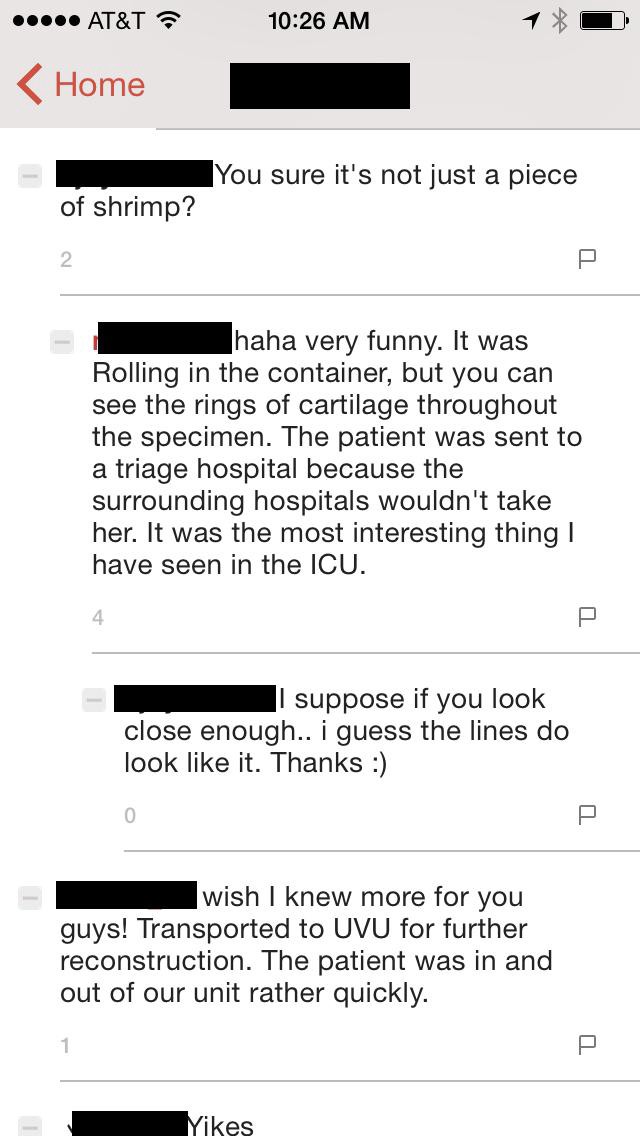
For an idea of what this photo looks like, just know that the first comment is sarcastic.
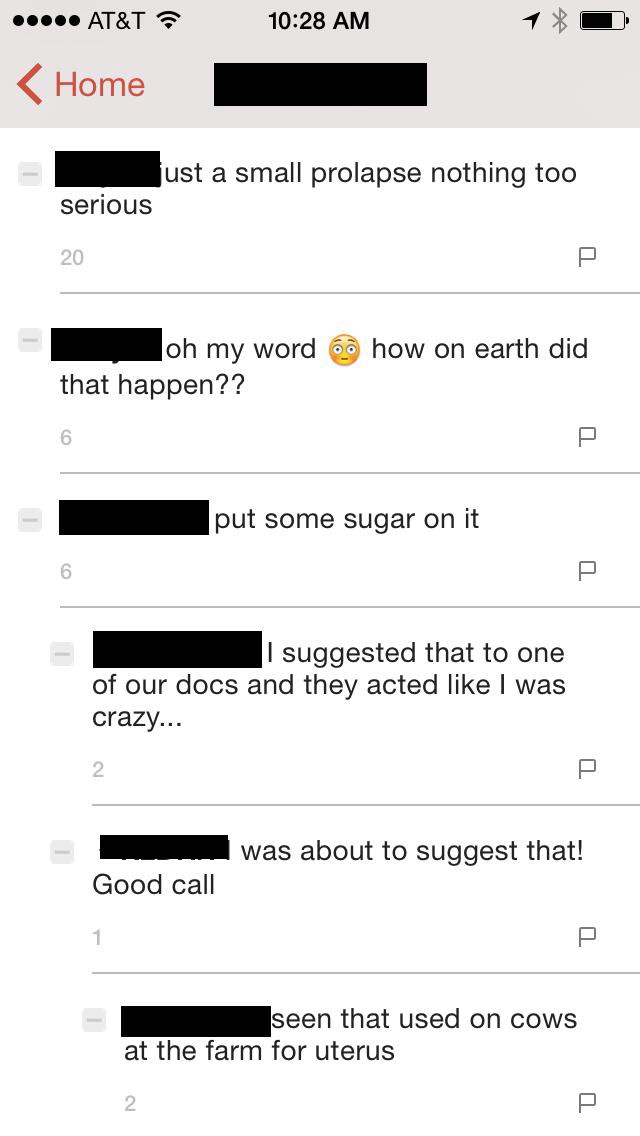
Part II:
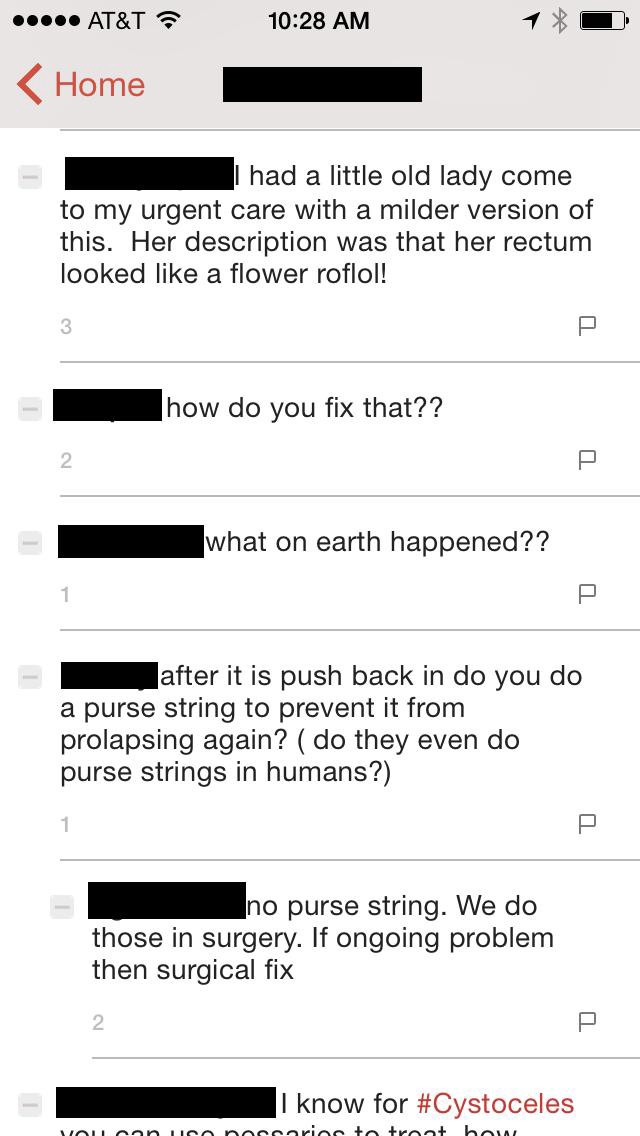
There are photos of children.
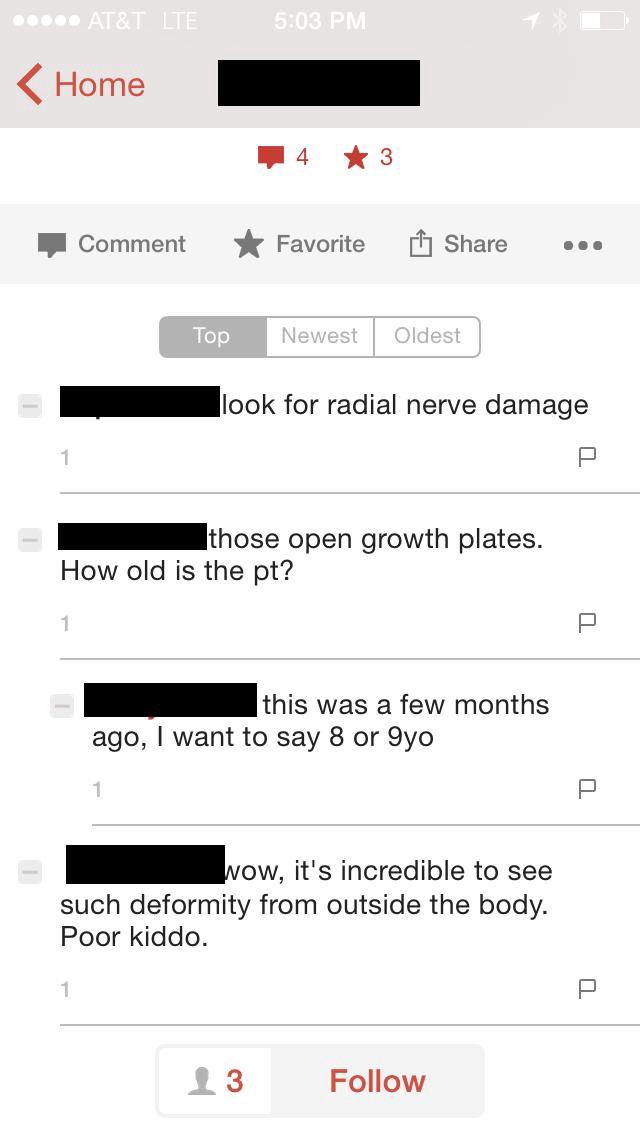
And little inside jokes about out-of-whack test results.
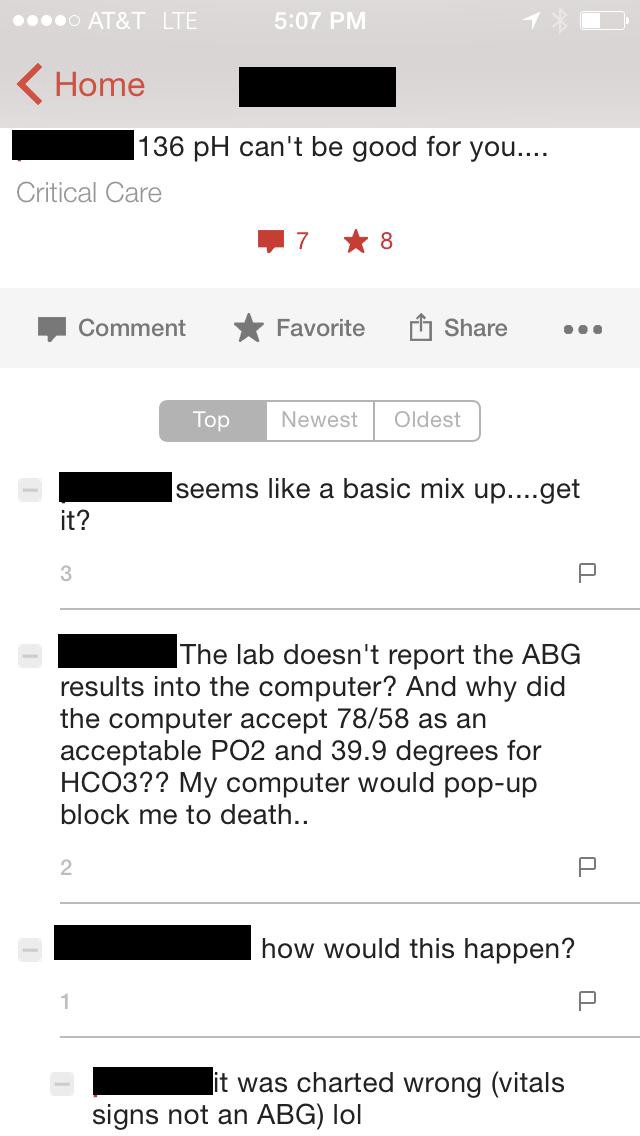
There is pity. Lots of pity.
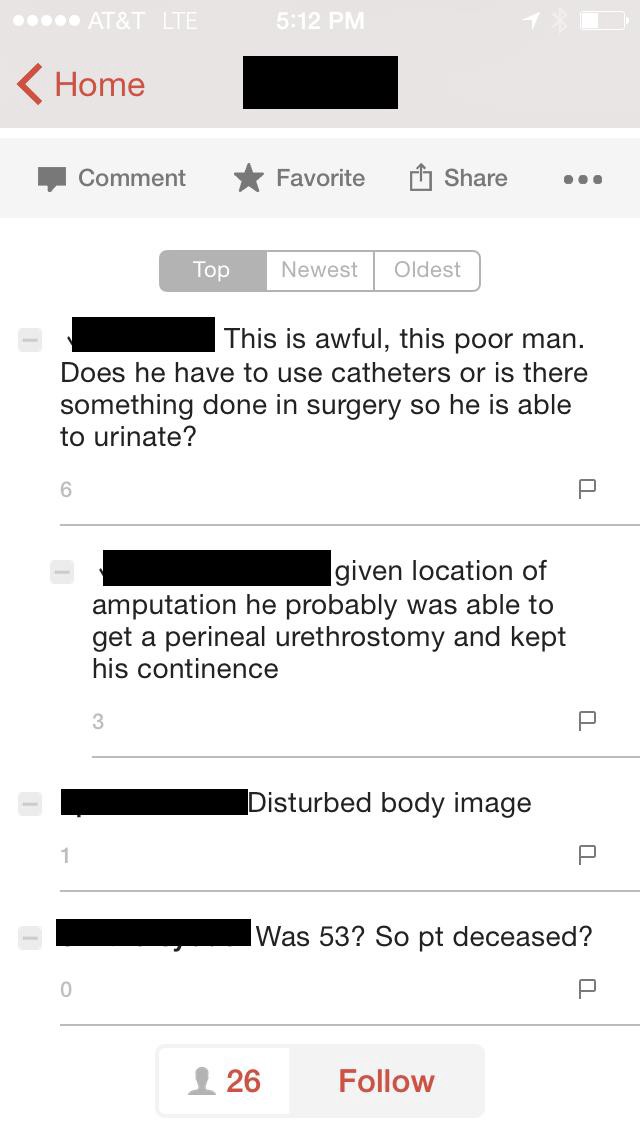
And, with some frequency, jokes. This is a photo of a hand with a nail driven through two fingers.
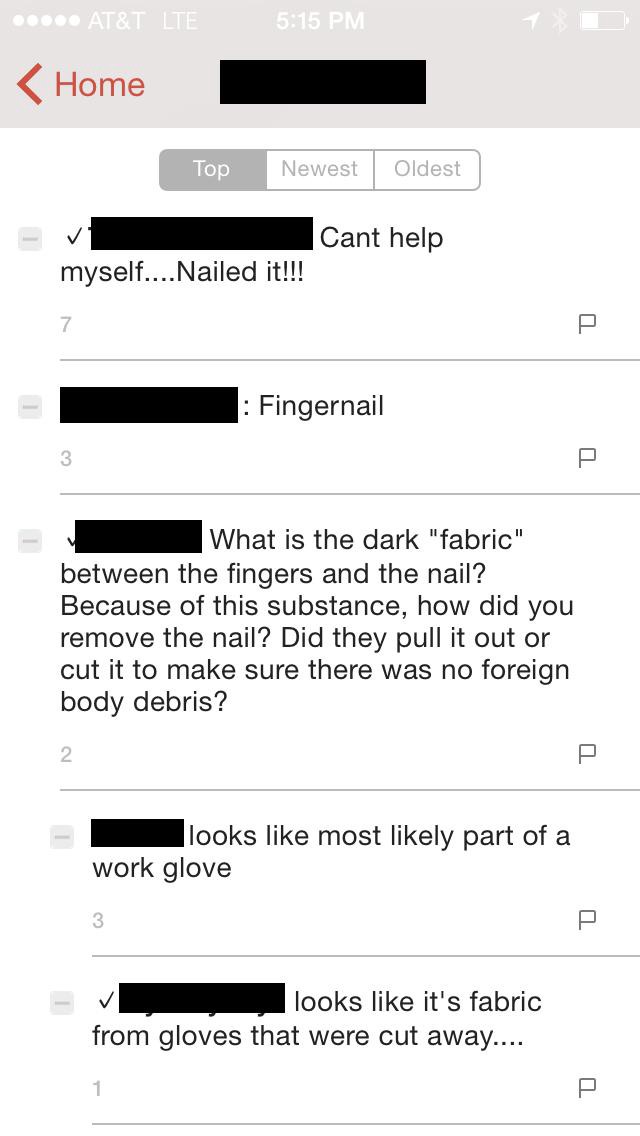
This is a severely gangrenous foot.
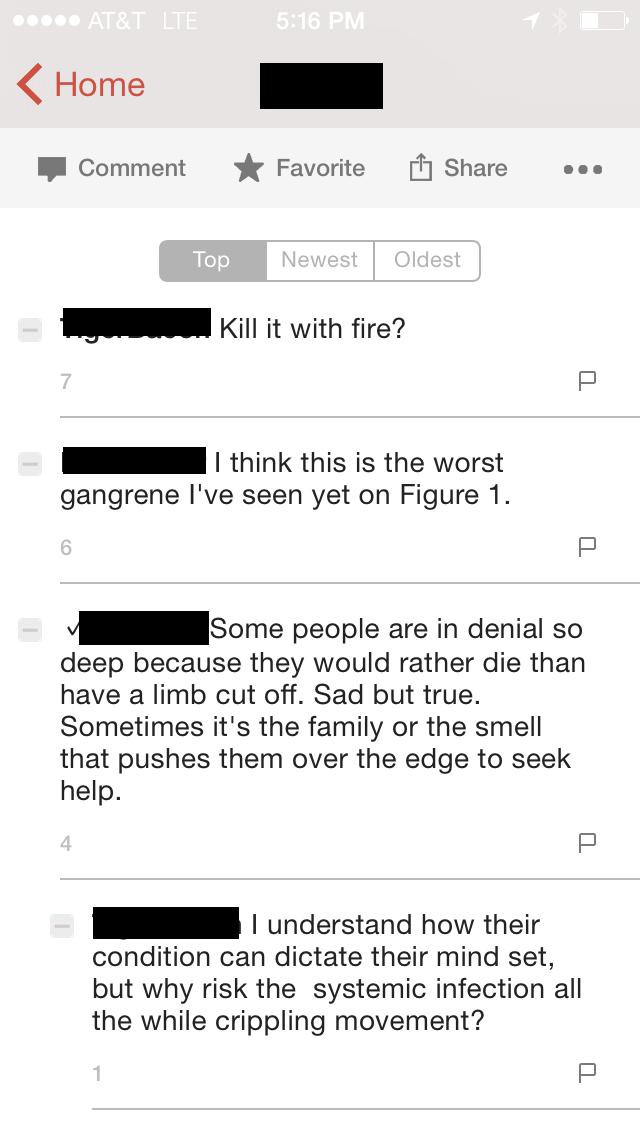
This is a photo of a hand that has been sliced open by a razor.
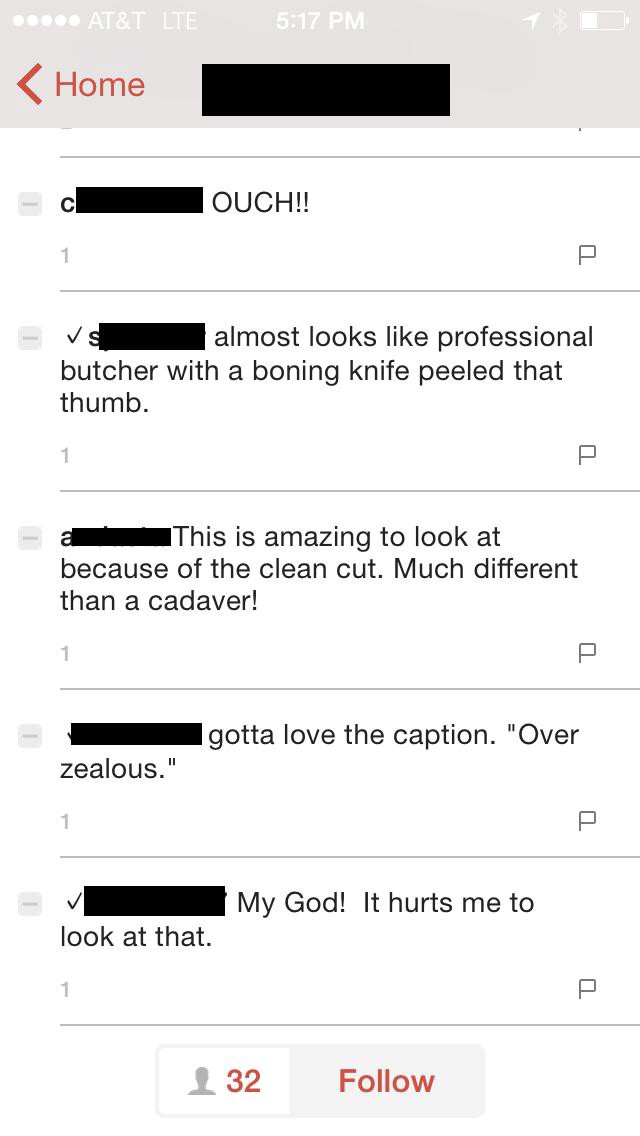
These doctors, for the most part, do not know each other. This is presumably what makes Figure 1 an appealing tool — it’s a new space in which people are trying to create utility. It’s also what makes it so difficult from a patient perspective. If this is a glimpse of how medicine is made, it might be more comfortable not to know.
H/t @Cwarzel
A Poem by Madhur Anand
by Mark Bibbins, Editor
Twenty-two Weeks
Nights lit up with a timer. Our programmable nests
evolving new synonyms. Spring is a thermostat,
a due date, a flutter. Some products are just simple
sums, but there is a harder green: multiplication
that fails to ripen. For now, well-bound prospectus, glow
on a branch. I read aloud and current children cheer.
“Oh, wie schön ist Panama!” A bear and a tiger
setting sail in a crate with the scent of bananas.
Madhur Anand’s first book of poems, A New Index for Predicting Catastrophes, will be published by McClelland & Stewart/Random House in April 2015.
You will find more poems here. You may contact the editor at poems@theawl.com.
Sounds Enumerated
In 2014, not a single artist’s album has gone platinum. Not one has managed to cross that million sales mark.
One album has managed to sell over a million copies so far this year, but it’s a soundtrack. The ever-popular Frozen soundtrack may slowly be working its way down the charts, but it is by far the best selling collection this year. Though it doesn’t have any marquee names on it — those that are usually expected to sell the best — the soundtrack has managed to move 3.2 million copies so far, and with winter coming, that number is sure to rise.
The most popular album of 2014 that was actually released in 2014 is Eric Church’s Outsiders; its highest-charting single is the song embedded above, “Give Me Back My Hometown.” It did not reach number one overall. Have you heard it? Me neither — not that many people have, in absolute terms. It’s gotten lots of radio play, and its YouTube video has nearly ten million views. In contrast, the music video for MAGIC!’s “Rude” currently has 180,359,175 views on Vevo, and Nicki Minaj’s “Anaconda” has 254,265,074. Just look at this whole page, full of obvious superstars who are sort of floating in a inter-industry void, lifted by enormous raw numbers but not at all fixed in space or time, at least officially. The music industry as it has been conceptualized for half a century does not exist.
New York City, October 15, 2014

[No stars] Reeking and full of incoherent menace, like a surly drunk squinting for an excuse to take a swing at someone. The humidity was suffocating. Clouds speeding under higher clouds opened moving blue spaces intermittently. Some of the spaces were large enough to let sun through for a while, creating a brief, gruesome caricature of summer. The wind came up and blew away the bright interlude. The light turned greenish and the sky slopped out enough rain to dampen the pavement. After a while it rained again, and again, splatting on the windows in the dark.
Attention Artists, Designers and Creators
by Awl Sponsors
It’s tough out there for working artists today. Finding the funding, resources and mentorship to realize your passion projects can feel overwhelming. Well, here’s your opportunity. THE SPACE is a non-profit organization that provides artists with substantial funding, allowing them to bring their digital art ideas to fruition. They’re looking for talented artists from all disciplines to submit proposals for their dream projects.
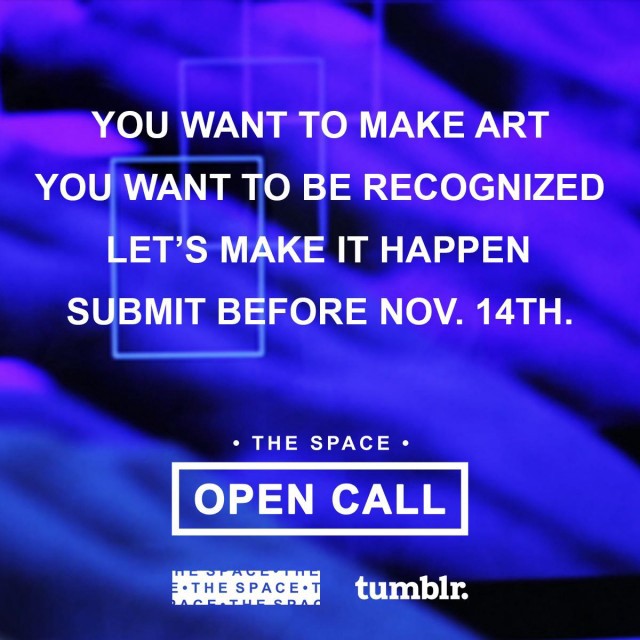
THE SPACE provides the opportunity for you to get genuine funding for that one crazy project you could never quite fit in your schedule. Like when John Cale of The Velvet Underground got funding to create an orchestra of flying drones. Or when musical pioneer John Peel got the time to create a virtually accessible archive of his massive record collection. Nothing’s off limits, this is about pushing the limit. The best part? You retain all rights to your project.
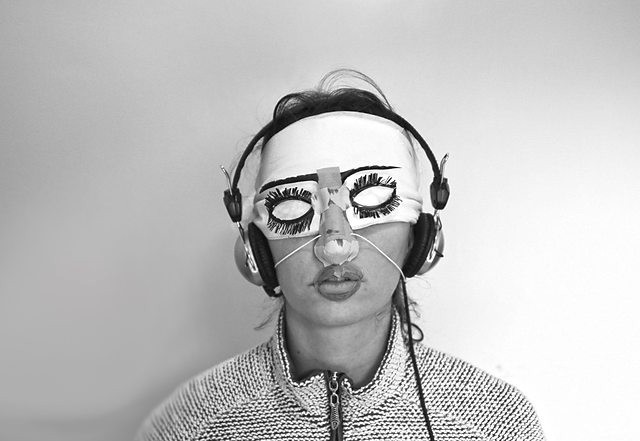
It’s easy. Simply submit a short description of your idea through THE SPACE Open Call, which runs from October 10th to November 14th 2014.
We only ask, that the project can live on the internet and be accessed on mobile and tablet devices. The art projects can take their point of departure in any artistic discipline, from music and film to visual arts and gaming.
The best projects will be shortlisted and the winners will be announced February 2015. So what are you waiting for? Submit your proposal today. and join the conversation at on twitter using the #TheSpaceOC hashtag.
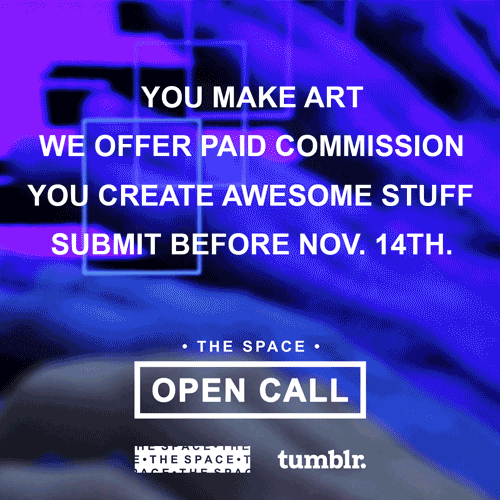
Hotels Are People Too
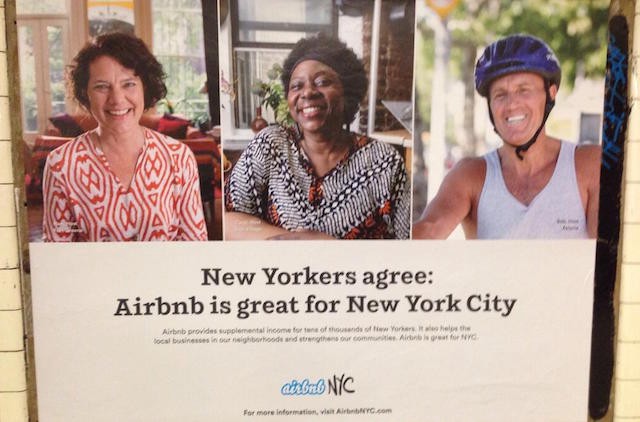
It’s increasingly hard to escape the sensation that the primary proprietors of the so-called sharing economy don’t so much share as take — from their users, from their contracted workers, from the localities in which they operate, by utilizing infrastructure that they do not contribute toward. It’s everybody else who shares.
The New York State Attorney General’s initial report on Airbnb in New York City, which analyzed full-apartment bookings (crucially, not room shares) with the service from 2010 until this past June, feels fairly conclusive in this regard. Even if you absolutely do not care at all that, according to the attorney general, seventy-two percent of the private bookings on Airbnb are technically illegal, or that real hotel operators are losing out hundreds of millions of dollars in bookings, or even maybe that the city has lost tens of millions of dollars in taxes the city has lost to Airbnb and its hosts, it’s frankly easy, as a renter in New York City (I mean, Jesus) to feel supremely agitated that last year, more than four-and-a-half thousand apartments listed on Airbnb were booked for short-term rentals for three months of the year or more, and of those, nearly half were booked by half the year or more — meaning apartments that could and should have been on the market were being largely used as hotels. (These apartments accounted for thirty-eight percent of the revenue to Airbnb and its hosts from units booked as private short-term rentals, according to the attorney general.)
And these are, in all likelihood, prime apartments! For all of Airbnb’s feel-good posturing in subway ads throughout the city, beaming that it’s bringing in income for strapped, individual residents throughout the metropolis, more than forty percent of the revenue for private rentals came from just three districts in Manhattan — Lower East Side/Chinatown, Chelsea/Hell’s Kitchen, and Greenwich Village/SoHo. (Unsurprisingly, the vast majority of Brooklyn bookings were in Williamsburg, Greenpoint, and what the report calls “brownstone Brooklyn.”) Perhaps these are long-time residents, struggling to hang onto their apartments in long-gentrified neighborhoods, using Airbnb to firm up their deathgrip on their lease. Sure, lol. In many cases it’s not even individuals who are making the money here: Just six percent of hosts did thirty-six percent of private apartment bookings, for thirty-seven percent of the revenue; the host with the most private units, two hundred and seventy-two of them, charged, on average, nearly three hundred and sixty dollars a night. This, in spite of Airbnb making of a show of throwing large-scale operators off of the service when the attorney general first began nosing around.
This is a far cry from a humble, average New Yorker occasionally renting out a room in their apartment to help pay that month’s rent — who would argue against that? not me — it’s exactly the kind of scenario that the 2011 law, which prohibits fully renting New York City apartments for less than a month, is designed to prevent: a gray market hotelier snapping up the apartment you had your eye on after weeks of squinting at Craigslist ads, or worse, droves of them seizing on a newly visible neighborhood, not only elevating rent prices and driving out current residents, but preventing the usual gentrifiers (lol) from ever moving in. Airbnb swore that wasn’t happening, but the data do not lie, as they are so fond of saying in Startuptopia.
In effect, every resident of New York City has been sharing the apartment market they participate in with Airbnb, who has profited handsomely from it; this year the attorney general expects “revenue to Airbnb and its hosts from private short-term rentals in New York City is expected to exceed $282 million.” What it seems that residents get in exchange, mostly, is fewer apartments to choose from, higher rents because of the diminished market, and lesser services from a city deprived of tens of millions of dollars in tax revenue. What is Airbnb sharing with them?
Photo by Richard Robbins
The Sad Parents of #Gamergate
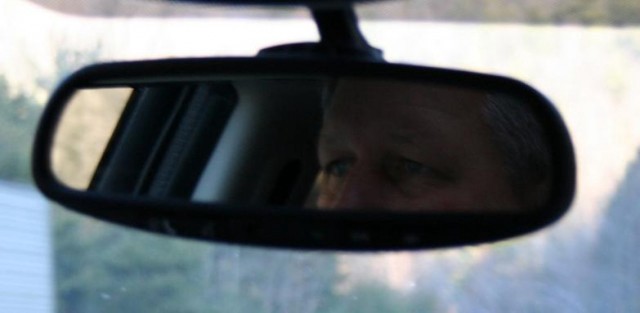
All around the country, parents are sitting down to have the talk with their children. Not about sex or mortality or college. They’re having the talk about Gamergate. From our own comments:
I have a 17 year old son and trying to point out the actual facts in this story is like trying to convince a rabid 70 year old FOX viewer that Obama is not a terrorist, born on Mars, here to take your guns.
“It’s about ethics, mom. Don’t you care about ETHICS?”
He’s not down with the death threats though, so I guess Yay?
Imagine! You hear your child talking animatedly about something. He steps closer and you hear him say “bias” and “Sarkeesian.” The words drip with spite. Later, you hear him through the bedroom door, talking to his webcam: “No, it’s about corruption in games journalism!” What do you do?
This is not an isolated phenomenon. On Metafilter:
My son is 19, with mild ASD. Sometime in the last 2 years he discovered 4chan. At first he was just reading /co, but now he is almost addicted to /pol and /v. Before he went back to college he was constantly online, getting all worked up about Zoe Quinn and gamergate.
I raised him to be a feminist, a liberal and a kind person. It hurts me that he is involved with such sexist, racist, anti-Semitic people. I don’t even have the words to express how sad this makes me.
Because he is 19, he of course knows more than me. I’m just his ignorant mom. So I don’t even know how to approach this conversation. What do I say that won’t just make him dig his heels in more?
Here’s what it looks like from the other side of the barrel. From Reddit:
My dad and I got into an argument about #GamerGate today. He said I need to try and see the other side’s point of view. But that’s the problem. They haven’t, they’ve just sat back and called us White Cis Heterosexual Male Misogynists. (BTW, if you do have a legitimate argument about #GamerGate that won’t simply devolve into cries of sexism for “cries of sexism”’s sake I [and several others, I’m sure] would love to hear them)
But the problem with arguing about #GamerGate with someone that isn’t a gamer, is they don’t truly understand what this experience puts the whole gaming community through.
We started #GamerGate with a simple request. Give us some f-ing integrity with your reporting. Don’t suck up to developers, over-hyping video games that couldn’t live up to the impossibly high standards you set them to (See Watch_Dogs and Destiny) Were they bad games? Not really, but they didn’t deserve as much of the hype that they received.
But my dad will insist that I need to show some respect for the other side’s opinion. So I simply ask to those who oppose #GamerGate, “Besides feeding the trolls of the internet attempting to sabotage a movement with good intentions, why would you oppose a call for ethics in gaming journalism?”
DAD. And:
I actually talked to my dad about this, and he looked at me funny. Not because he thought I was wrong, or that we were in the wrong, but I don’t think me explaining the opposition made absolutely any sense to him.
Some parents are attempting to engage in earnest, before things curdle:
He likes to think that the GGrs are benign heroes who are “misunderstood”. Um, I think not. I’ve sent him two new links. BOOM. Take that!
— Michele Mills (@mills_michele) October 12, 2014
@Palaxar What other side?How can there be nuance if there are threats of violence?Though I TOTALLY understand that not ALL gamers hate women
— DougalsBeard (@DougalsBeard) October 16, 2014
@Palaxar I appreciate the dialogue! My son is a gamer and I want him to have open eyes about all good and bad about the community…
— DougalsBeard (@DougalsBeard) October 16, 2014
And a few parents are trying to preempt things entirely:
@moryan I was just trying to explain it all to my 11YO gamer son, but it’s hard to make it not sound INSANE 🙁
— Matt Mitovich (@MattMitovich) October 15, 2014
Received a text from my fourteen year old son “ What’s gamer gate?” What the hell do I say here?
— Ross Ireland (@R_J_I) October 15, 2014
I want to give context and not just drop “ they’re bad” but the depths of it is noxious. How do I explain it to a kid?
— Ross Ireland (@R_J_I) October 15, 2014
But then there’s the other type of Gamergate parent. The MOVEMENT parent:
I told my son about what SJWs want to do to games His response “but that won’t make games fun then” Priceless from an 11 Year old #gamergate
— Beelzs Zabub (@BeelzsZabub) September 26, 2014
@daveweigel My son the “gamer” is learning the true nature of the American “news” industry earlier than most people do thanks to this story.
— Ballistic Prince (@BallisticPrince) October 15, 2014
There are some self-described moderates of course:
I’m a gamer, I’m not ashamed of calling myself that and I take offense at the notion that I should. I’ve been playing video games for more than 30 years, been a game developer for more than 10. I’m enjoying playing video game with my son and I’m looking forward to be playing them with my soon to be born daughter. I refuse to be held accountable for the actions of others.
I’m a left leaning liberal and I fully support GamerGate.
There are proud parents demonstrating solidarity with their Gamergate kids:
My son is following it and is outraged enough for our whole family. It’s probably justified too as people may well have based spending decisions on biased information.
There are parents cautiously expressing concern:
@jamesmelay @Boogie2988 My son is a 15 y/o gamer (and fan of Boogie’s) and I am hoping that this doesn’t effect his identity negatively.
— Vance (@VanceMc14) October 14, 2014
It’s October, 2014. Do you know which side of Gamergate your child is on?
Image by Flightsaber
Leon Bridges, "Coming Home"
Leon Bridges, “Coming Home”
Via GvB, a supremely satisfying soul pop throwback to ~60 years ago which, obviously, you can read all about on the artist’s Tumblr.
Countdown to the Last-Ever October Surprise
Countdown to the Last-Ever October Surprise

It’s election season. It’s October. According to the political-astrological calendar, this is very important: It’s time for an October surprise. Juan Williams thinks the surprise will be war:
To be clear, Republicans remain a slight favorite to win enough seats to claim the majority of the U.S. Senate. But the twists and turns of war have the capacity to create one legendary October political surprise.
He is using the conspiratorial definition of “October Surprise,” as opposed to the literal surprise definition. War for votes. Bob Beckel, conspiracy theorist, agrees: “I think I know what it is, but it is going to shake things up…it’s going to have to do with national security.”
Darrell West has a different idea:
[T]he real October surprise will come from billionaires dropping millions of dollars in a handful of Senate races seeking to move the needle one or two points to secure the election.
That would throw things off! But you could argue that this wouldn’t really be a surprise.
Yesterday, anyway, Washington achieved clarity. The official October Surprise is Ebola Hemorrhagic Fever. (Congratulations to Ebola Hemorrhagic Fever.)
Chris Cillizza in the Washington Post:
Add it all up and you are left with this conclusion: Ebola is the October surprise of the 2014 midterms. That is, an unexpected event that has the potential to roil the electorate in all sorts of unpredictable ways.
Elise Viebeck at The Hill concurs:
Ebola has become the October surprise of this year’s midterm elections, with Democrats and Republicans doing battle over everything from restrictions on travel to the disposal of a victim’s remains.
It says something rotten that the consensus predictions for an October surprise were partisan assumptions that one party or the other would effectively rig the election; it says something else, something more sad than sinister, that, according to pre-eminent take-havers and score-callers, the actual October surprise is an out-of-control disease with no consciousness or ideology, a disease that has killed thousands of people and will kill thousands more.
Imagine being unable to read about Ebola without thinking “is this, finally, the October Surprise?” Imagine watching a meteor flame through the atmosphere and thinking, “this is going to be very, very inconvenient for incumbents.”
Image from Wikimedia Commons
New York City, October 14, 2014

★★★★ Low clouds were moving fast in the humid morning. In the span of a viola lesson, the dazzling sunlight had been covered up by a diffuse layer of them. In the span of a subway ride downtown, that cloud-stuff had shaped up into at least one impressively solid cloud in a field of blue; other cloud remnants drifted here and there. It was necessary or worthwhile to get out into the damp warmth to fetch lunch. Across the Bowery, the breeze was cooler. For a moment, near the end of afternoon, the lowering sun made it indoors. Then by rush hour a sort of cover of sort of clouds, mottled dusk-blue and gray, had returned.
